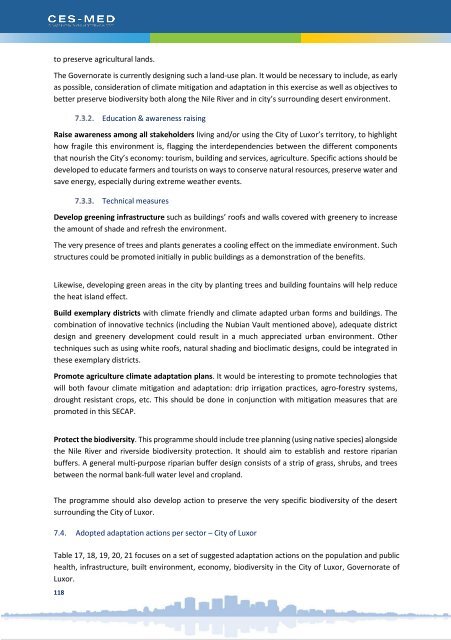280218_Luxor-Egypt SECAP Final_revised
You also want an ePaper? Increase the reach of your titles
YUMPU automatically turns print PDFs into web optimized ePapers that Google loves.
impacts on low-level lands in Delta and adjacent highly populated cities such as Alexandria and Port<br />
Said. Consequently, this will result in a more significant challenge, which is the migration of people<br />
from the affected areas to other areas, thus affecting the efficiency of different services and increasing<br />
the financial cost required for their development.<br />
As forth tourism sector, coral reefs, which constitutes a major attraction in Red Sea resorts are highly<br />
vulnerable to climate change.<br />
In urban areas, heat islands formed by hot air arising from the increasing energy use in buildings<br />
represent the main concern in hot arid climates. One of the most significant potential negative impacts<br />
of climate change is the harm inflicted on national heritage as result of temperature rise, sandy winds<br />
and ground water. However, this isn’t just a national concern. Instead, it is a global challenge since this<br />
heritage is part of the human heritage.<br />
Health sector<br />
In terms of Health, climate change increases direct and indirect negative impacts on public health in<br />
<strong>Egypt</strong>. For example, in 2015 the negative impacts are represented in higher death rate due to heat<br />
stress.<br />
Energy sector<br />
In the energy sector, the increase in temperature negatively affects the efficiency of conventional<br />
power plants and photovoltaic cells. Also, the rise in sea level threatens the electric power plants and<br />
networks located along the coasts. In addition, the negative impact of climate change on rainfall rates<br />
and rain distribution across different regions negatively affects power generation from hydropower<br />
plants, especially in Upper <strong>Egypt</strong>. Moreover, the increased demand in electricity consumption rates as<br />
a result of the excessive use of air conditioners due to unprecedented heat waves that hit <strong>Egypt</strong> that<br />
of August 2015 for 2 weeks at 49 degrees Celsius.<br />
6.2.2.1 Water Resources<br />
112<br />
<strong>Egypt</strong>'s intended actions to promote resilience<br />
Several measures are currently being considered in <strong>Egypt</strong> to adapt to decreasing water resources or<br />
increasing Nile flows. These primarily include:<br />
- Maintaining water level in Lake Nasser,<br />
- Increasing water storage capacity - Improving irrigation and draining systems,<br />
- Changing cropping patterns and farm irrigation systems,<br />
- Reducing surface water evaporation by redesigning canal cross sections,<br />
- Developing new water resources through upper Nile projects,<br />
- Rain water harvesting – Desalination, and<br />
- Treated wastewater recycling - Increased use of deep groundwater reservoirs.<br />
In addition, public awareness is being raised on the need for rationalizing water use, which has been<br />
manifested at the national level in 2015 and increasingly in 2016.<br />
6.2.2.2 Coastal Zones<br />
Adaptation options for coastal zones are highly site-dependent. However, changes in land use,<br />
integrated coastal zone management, and proactive planning for protecting coastal zones are

















